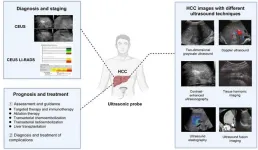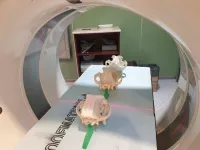(Press-News.org) INDIANAPOLIS – Palliative care, specialized medical care focusing on providing relief from the symptoms -- including pain -- and the stress of serious illness, is underutilized in nursing homes, despite the large number of nursing home residents living with a serious illness such as cancer, dementia, Parkinson’s disease, heart failure or chronic obstructive pulmonary disease.
A qualitative study, published in the Journal of the American Geriatrics Society, analyzes lack of palliative care referrals for nursing home residents and proposes ways to address this healthcare gap. In addition to examining existing referral patterns, the authors explore recommendations for ideal criteria and create a substantive framework for palliative care referrals in nursing homes.
Palliative care is not the same as, nor is it limited to, hospice care. Palliative care, a broader term, can be delivered to anyone with serious illness, often along with other therapies and treatments.
Depending on the needs of the nursing home resident, one palliative care consultation may be all that is needed to review medications to establish a plan of care. Other residents who have ongoing symptom-management needs or who experience multiple changes in status, may need ongoing palliative care support.
“People in nursing homes may receive care there for years. They often have serious and advanced medical illnesses and have the need for the symptom management and supportive care that palliative care provides. Many nursing home residents with advanced disease, particularly those with advanced dementia, have goals of care consistent with comfort care,” said study co-author and Regenstrief Institute Research Scientist Kathleen Unroe, M.D., MHA. “While it is typically available in hospital and cancer center settings, unfortunately, palliative care is not consistently and widely available in every nursing home in the United States. It really depends on where you live. Non-hospice palliative care in nursing homes is hard to come by.” Dr. Unroe also is an associate professor of medicine at the Indiana University School of Medicine – Indianapolis.
“Primary care providers, which I am in the nursing home setting, can do a lot in terms of supportive care. There are some cases, however, where we need palliative care consultants to support us to provide specialized palliative care,” Dr. Unroe noted. “Despite documented unmet needs for palliative care in nursing homes, we struggle to deliver these services. It is, however, happening in some markets and some facilities. The goal of this study was to interview people who are doing this work, learning how they're doing it, so that we can create a best practice model and help define what the standard of care should be.”
To expand palliative care utilization in nursing homes, the research team indicates it is imperative that staff members be aware of the significance of palliative care and that they also be equipped with tools to identify when this care is needed,
Laying the foundation for the development of evidence-based referral criteria, the researchers propose the exploration of five domains or themes for identification of nursing home residents with unmet palliative care needs:
goals of care support
uncontrolled symptoms
serious illness
global indicators of decline
end of life
“We need to keep figuring out creative solutions for frontline staff and primary care providers to have palliative care training so that we can meet many of the care needs of residents. We also need to have systematic processes to identify who needs a higher level, more specialized palliative care,” added Dr. Unroe. “If you or a loved one transitions into a nursing facility, it is absolutely appropriate to ask what they do for palliative care in that facility. Even if you or your loved one do not need those services today, you may in the future, and it's good to know the resources that are available.”
The research team continues to evaluate current practice and to develop and test new evidence-based best practice tools and models of care with the goal of creating and applying scalable models to disseminate palliative care practice in nursing homes.
“Our study highlights the need for the implementation of standardized referral criteria to ensure equitable access to palliative care in nursing homes," said Connie S. Cole, PhD, DNP, of the University of Colorado, the study's lead author. "Providing important education about palliative care allows residents and families to make informed decisions regarding their care preferences.”
“Palliative care in nursing homes: A qualitative study on referral criteria and implications for research and practice” is published in Journal of the American Geriatrics Society.
This work was supported by the National Institutes of Health’s National Institute on Aging, Grant/Award Number: 5T32AG044296 and NIH’s National Institute of Nursing Research, Grant/Award Number: K23NR017663; the Gerontological Advance Practice Nurses Association Foundation; University of Colorado School of Medicine, Anschutz Medical Campus; and the Gordon and Betty Moore Foundation.
Authors and affiliations:
Connie S. Cole, PhD, DNP, RN-GERO, NP-C, ACHPN1; C. Robert Bennett, PhD, CPNP-AC1;
Joan G. Carpenter, PhD, CRNP, ACHPN, FPCN2;
Regina M. Fink, PhD, APRN, CHPN, AOCN, FAAN1,3;
Amy Jackson, BSN2;
Kathleen T. Unroe, MD, MHA, MS4,5;
Cari R. Levy, MD, PhD1.
1University of Colorado School of Medicine, Aurora, Colorado, USA
2University of Maryland School of Nursing, Baltimore, Maryland, USA
3University of Colorado College of Nursing, Aurora, Colorado, USA
4School of Medicine, Indiana University, Indianapolis, Indiana, USA
5IU Center for Aging Research, Regenstrief Institute, Indianapolis, Indiana, USA
Kathleen Unroe, M.D., MHA
In addition to being a research scientist with the Indiana University Center for Aging Research at Regenstrief Institute, Kathleen Unroe, M.D., MHA, is an associate professor of medicine at the Indiana University School of Medicine – Indianapolis and a practicing geriatrician.
END
Palliative care is underutilized in nursing homes
Study examines the challenge and proposes avenue for improvement
2024-07-16
ELSE PRESS RELEASES FROM THIS DATE:
Understanding others: By age three, we can do this with mirror neurons
2024-07-16
Milan, July 15, 2024 – By the age of three, children are capable of understanding others, "mirroring" those they are with to imitate and anticipate their intentions. They are able to do it thanks to the sophisticated neurofunctional architecture that is necessary to understand others' intentions, the mirror neurons, that result already active at this age.
It’s the result of a study published in the prestigious journal PNAS, led by the collaboration between Giacomo Rizzolatti of the University of ...
Oil and natural gas development in Permian is a key source of ozone pollution in Carlsbad Caverns National Park
2024-07-16
EMBARGO: THIS CONTENT IS UNDER EMBARGO UNTIL 9 A.M. U.S. EASTERN STANDARD TIME ON JULY 16. INTERESTED MEDIA MAY RECIVE A PREVIEW COPY OF THE JOURNAL ARTICLE IN ADVANCE OF THAT DATE OR CONDUCT INTERVIEWS, BUT THE INFORMATION MAY NOT BE PUBLISHED, BROADCAST, OR POSTED ONLINE UNTIL AFTER THE RELEASE WINDOW.
New research shows that ozone concentrations at Carlsbad Caverns National Park frequently exceed Environmental Protection Agency health standards, likely due to oil and natural gas development in the Permian Basin and surrounding region.
The work was led through the Department of Atmospheric Science at Colorado State University and is part of ...
E. coli variant may cause antimicrobial resistance in dogs, humans
2024-07-16
ITHACA, N.Y. – Researchers studying antimicrobial-resistant E. coli – the leading cause of human death due to antimicrobial resistance worldwide – have identified a mechanism in dogs that may render multiple antibiotic classes ineffective.
The paper, which will publish July 16 in the journal Applied and Environmental Microbiology at 9:00am EST, opens up new avenues for therapies to treat both animals and humans – and establishes clinical infections in dogs as a surveillance approach for public health.
The research team analyzed more than 1,000 genomes of the resistant ...
Ultrasonography of hepatocellular carcinoma: From diagnosis to prognosis
2024-07-16
Hepatocellular carcinoma (HCC) is a primary malignancy of the liver and one of the leading causes of cancer-related deaths worldwide. Early detection and accurate diagnosis are crucial for effective management and improved survival rates. Ultrasound (US) technology has significantly advanced and plays a pivotal role in the surveillance, diagnosis, and treatment of HCC. This paper delves into various ultrasound techniques and their clinical applications in HCC management.
Two-dimensional gray-scale ultrasound is a fundamental imaging technique for HCC surveillance. ...
Partisan politics and perceptions of immorality
2024-07-16
Democrats and Republicans overestimate the percentage of people in the opposing party who approve of widely agreed-upon moral wrongs, such as theft or animal abuse, according to a study. Today, Americans hate their opposing political party more than they love their own party, and political animosity and dehumanization of opposing party members have been on the rise for decades. Curtis Puryear and colleagues looked for a “basic morality bias” in social media posts from 5,806 political partisans by searching for words that referencd ...
Should AI be used in psychological research?
2024-07-16
Mohammad Atari and colleagues explore the promise and peril of using large language models (LLMs) in psychological research, beginning by urging researchers to also ask themselves whether and why they should use LLMs—not just how they should use them. The authors caution against using LLMs as a replacement for human participants, noting that LLMs cannot capture the substantial cross-cultural variation in cognition and moral judgement known to exist. Most LLMs have been trained on data primarily from WEIRD (Western, Educated, Industrialized, Rich, Democratic) sources, disproportionately in English. Additionally, although ...
AI makes human-like reasoning mistakes
2024-07-16
Large language models (LMs) can complete abstract reasoning tasks, but they are susceptible to many of the same types of mistakes made by humans. Andrew Lampinen, Ishita Dasgupta, and colleagues tested state-of-the-art LMs and humans on three kinds of reasoning tasks: natural language inference, judging the logical validity of syllogisms, and the Wason selection task. The authors found the LMs to be prone to similar content effects as humans. Both humans and LMs are more likely to mistakenly label an invalid argument as valid when the semantic content is sensical and believable. LMs are also just as bad as humans at the Wason selection task, in which the participant ...
Waterpower scarcity and coal use during the Industrial Revolution
2024-07-16
A study combining history, economics, and fluvial geomorphology examines the causes of the adoption of coal power during the Industrial Revolution in Great Britain. At the beginning of the mechanization of the textile industry in Britain, most machines were powered with waterpower. Eventually waterpower was replaced by using coal to make steam power and the causes of this shift have long been debated. One influential hypothesis has been that waterpower became scarce in the industrial heartland of northwest England during the early 19th century, as all available suitable sites were already fitted with ...
Capturing carbon with energy-efficient sodium carbonate−nanocarbon hybrid material
2024-07-16
Industrial emissions are one of the main sources of climate change-inducing carbon dioxide (CO2). While adopting renewable and clean energy alternatives is one option for mitigating these carbon emissions, carbon capture technology is another solution to control CO2 emissions. In big CO2-emitting industries, such as cement, oil refineries, and thermal power plants, carbon capture technology can be easily applied to remove CO2 emissions directly at the source at a feasible cost and with low energy consumption. Different materials have been explored for CO2 capture in factories, including zeolites, metal−organic frameworks, natural minerals, alkalis, ...
Digital dog and cat skull database
2024-07-16
The ELTE Eötvös Loránd University is home to the skulls of more than 150 dog breeds and other animals. To make this unique collection accessible to all, researchers digitised the skulls of 431 dogs, cats and wild relatives. The database can be used for educational and research purposes.
Tibor Csörgő, a researcher at ELTE, has been collecting animal skulls for decades to teach anatomy to biologists. The shape of the skull varies considerably between species and breeds, especially in dogs, where, for example, greyhounds have long skulls and the now popular French bulldogs have rounded skulls.
A skull biobank ...
LAST 30 PRESS RELEASES:
Injectable breast ‘implant’ offers alternative to traditional surgeries
Neuroscientists devise formulas to measure multilingualism
New prostate cancer trial seeks to reduce toxicity without sacrificing efficacy
Geometry shapes life
A CRISPR screen reveals many previously unrecognized genes required for brain development and a new neurodevelopmental disorder
Hot flush treatment has anti-breast cancer activity, study finds
Securing AI systems against growing cybersecurity threats
Longest observation of an active solar region
Why nail-biting, procrastination and other self-sabotaging behaviors are rooted in survival instincts
Regional variations in mechanical properties of porcine leptomeninges
Artificial empathy in therapy and healthcare: advancements in interpersonal interaction technologies
Why some brains switch gears more efficiently than others
UVA’s Jundong Li wins ICDM’S 2025 Tao Li Award for data mining, machine learning
UVA’s low-power, high-performance computer power player Mircea Stan earns National Academy of Inventors fellowship
Not playing by the rules: USU researcher explores filamentous algae dynamics in rivers
Do our body clocks influence our risk of dementia?
Anthropologists offer new evidence of bipedalism in long-debated fossil discovery
Safer receipt paper from wood
Dosage-sensitive genes suggest no whole-genome duplications in ancestral angiosperm
First ancient human herpesvirus genomes document their deep history with humans
Why Some Bacteria Survive Antibiotics and How to Stop Them - New study reveals that bacteria can survive antibiotic treatment through two fundamentally different “shutdown modes”
UCLA study links scar healing to dangerous placenta condition
CHANGE-seq-BE finds off-target changes in the genome from base editors
The Journal of Nuclear Medicine Ahead-of-Print Tip Sheet: January 2, 2026
Delayed or absent first dose of measles, mumps, and rubella vaccination
Trends in US preterm birth rates by household income and race and ethnicity
Study identifies potential biomarker linked to progression and brain inflammation in multiple sclerosis
Many mothers in Norway do not show up for postnatal check-ups
Researchers want to find out why quick clay is so unstable
Superradiant spins show teamwork at the quantum scale
[Press-News.org] Palliative care is underutilized in nursing homesStudy examines the challenge and proposes avenue for improvement





